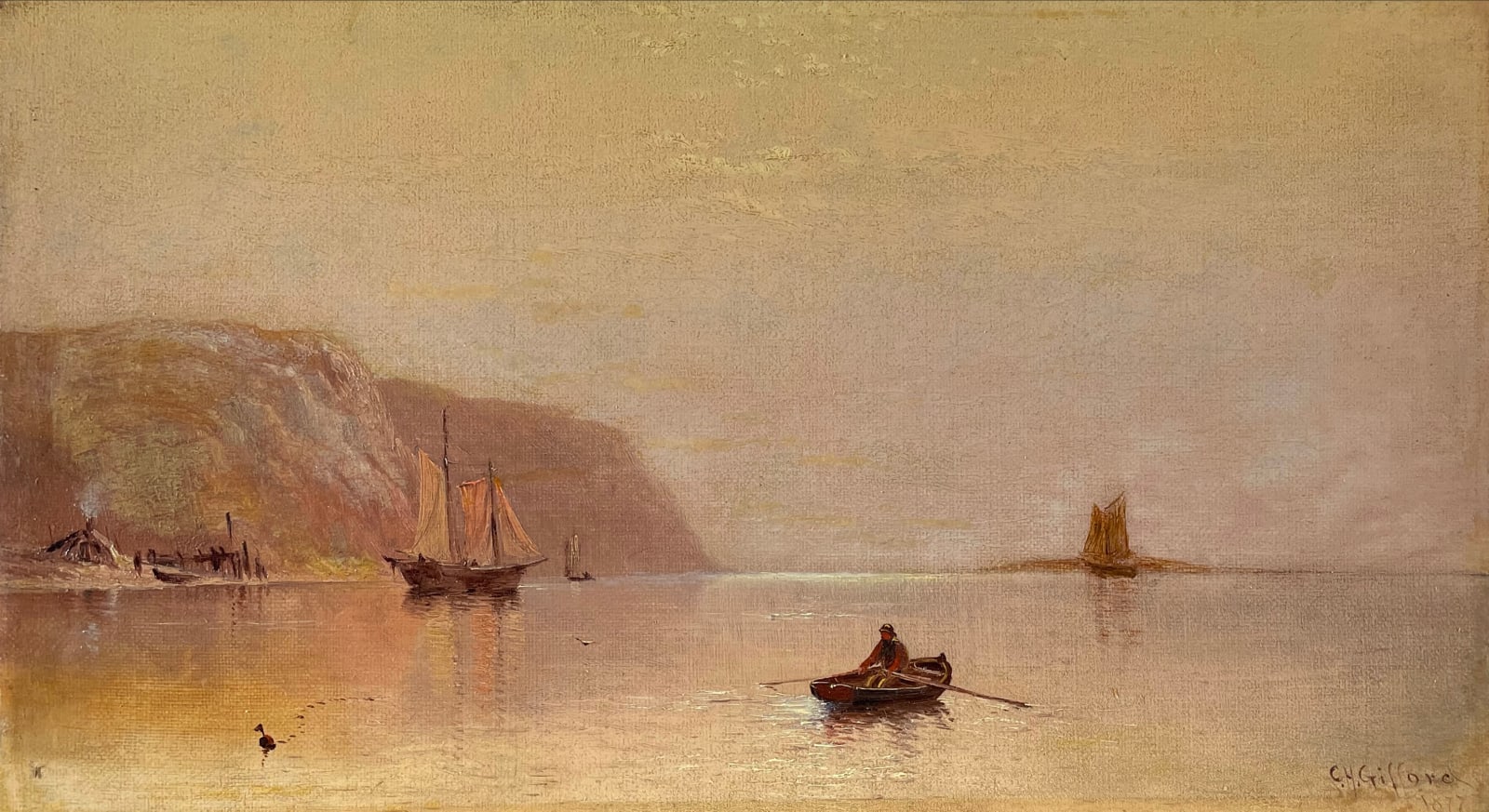Charles Henry Gifford
View at Dawn, 1877
Oil on canvas
7 1/8 x 12 5/8 inches (18 x 32 cm)
Framed dimensions: 12 x 17 inches
Framed dimensions: 12 x 17 inches
Signed and dated lower right: C.H. Gifford / 1877
Charles Henry Gifford was born in the Massachusetts coastal village of Fairhaven in 1839, during the heyday of the whaling industry. Although fascinated by art at an early age, his...
Charles Henry Gifford was born in the Massachusetts coastal village of Fairhaven in 1839, during the heyday of the whaling industry. Although fascinated by art at an early age, his eventual career was delayed by his father's desire for him to learn a trade. The son of a ship's carpenter, he was first apprenticed to that trade, then learned shoemaking, to which he applied himself until 1862, when he abandoned this trade to fight in the Civil War. After the end of his enlistment, which included a month as a prisoner of war in Virginia's infamous Confederate ‘Libby’ Prison, Gifford in 1865 returned to Fairhaven and resumed his trade as a cobbler, but by 1866 he was painting, and dedicated the remainder of his life to the pursuit of his art.
He was essentially self-taught, but his exposure to the rich artistic milieu of New Bedford greatly influenced his work. Alfred van Beest, William Bradford, Albert Bierstadt, R. Swain Gifford, and Albert Pinkham Ryder were among the many artists who lived and worked, or exhibited in the community. Many years later Gifford wrote: "What set me to painting was...seeing an exhibition of Bierstadt's paintings...I was so enthused that I came home, got some cloth and paint and went right to work".
Gifford was a Luminist painter, concerned with both subtle and dramatic effects of light, stillness, precise realism, and softly glowing surfaces. By the late 1860’s he had become an established and successful New Bedford marine artist, specializing in small detailed maritime views of coastal Massachusetts such as this painting titled Sea Witch, Quincy. These works typically measured about nine by fourteen inches, and Gifford referred to them as "my little gems".
By the 1870’s, despite his lack of formal artistic training, he was producing highly accomplished works and his career was firmly established. The later half of the decade found Gifford executing a series of larger luminous works that rivaled the best of William Bradford, Fitz H. Lane, and his childhood icon, Bierstadt.
He painted along the New England Coast, including Nantucket, Cuttyhunk, and the Elizabeth Islands, and inland to the White Mountains, Niagara Falls and Lake George. Toward the end of his career he also worked in watercolor, continuing his renditions of both naturalistic detail and subtle atmospheric effects.
He was essentially self-taught, but his exposure to the rich artistic milieu of New Bedford greatly influenced his work. Alfred van Beest, William Bradford, Albert Bierstadt, R. Swain Gifford, and Albert Pinkham Ryder were among the many artists who lived and worked, or exhibited in the community. Many years later Gifford wrote: "What set me to painting was...seeing an exhibition of Bierstadt's paintings...I was so enthused that I came home, got some cloth and paint and went right to work".
Gifford was a Luminist painter, concerned with both subtle and dramatic effects of light, stillness, precise realism, and softly glowing surfaces. By the late 1860’s he had become an established and successful New Bedford marine artist, specializing in small detailed maritime views of coastal Massachusetts such as this painting titled Sea Witch, Quincy. These works typically measured about nine by fourteen inches, and Gifford referred to them as "my little gems".
By the 1870’s, despite his lack of formal artistic training, he was producing highly accomplished works and his career was firmly established. The later half of the decade found Gifford executing a series of larger luminous works that rivaled the best of William Bradford, Fitz H. Lane, and his childhood icon, Bierstadt.
He painted along the New England Coast, including Nantucket, Cuttyhunk, and the Elizabeth Islands, and inland to the White Mountains, Niagara Falls and Lake George. Toward the end of his career he also worked in watercolor, continuing his renditions of both naturalistic detail and subtle atmospheric effects.
Provenance
Private collection, until 2018;Willis Henry Auctions, Duxbury, Massachusetts, April 14, 2018, lot 27D;
Heller Washam Antiques, until 2025
Please join our mailing list
* denotes required fields
We will process the personal data you have supplied in accordance with our privacy policy (available on request). You can unsubscribe or change your preferences at any time by clicking the link in our emails.



